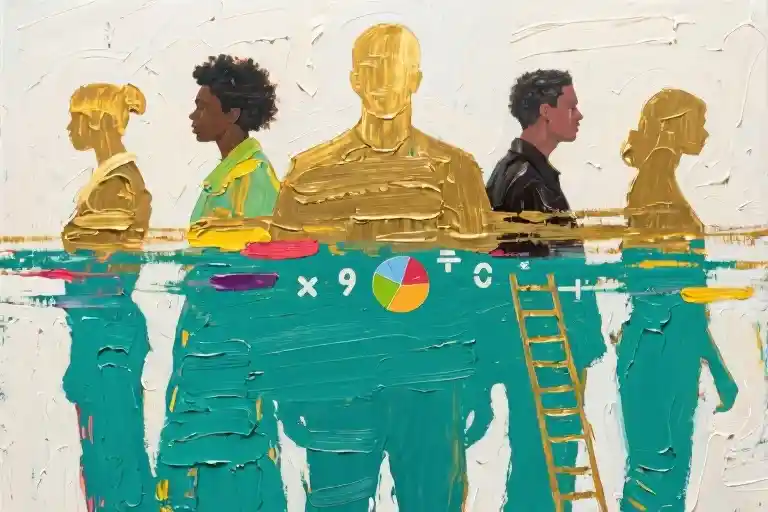The phrase “You are the average of the five people you spend the most time with” has been shared over 2.3 million times on LinkedIn and appears in nearly every modern personal development book. Google Trends shows searches for this quote have increased 170% in the past five years, peaking every January as people reconsider their social circles during New Year resolutions. Yet beneath its viral appeal lie three uncomfortable questions most self-help gurus won’t address:
First, the mathematical absurdity – if one friend is a billionaire entrepreneur, another a Buddhist monk, and your orange tabby cat (who technically meets the “spend time with” criteria), what exactly is being averaged? Your incomes? Spiritual enlightenment levels? Napping skills? The quote collapses under basic arithmetic scrutiny much like claiming your BMI represents the average of your five most recent meals.
Second, the unspoken hierarchy it creates. Reddit threads overflow with anxious posts like “Does my retired father count if he doesn’t ‘add value’?” or the chillingly transactional “How to gracefully phase out friends below your new salary bracket.” We’ve turned human connection into a spreadsheet exercise, evaluating relationships through the lens of social capital accumulation rather than mutual growth.
Third, the passive role it assigns us. Hidden in this framing is the assumption we’re merely sponges absorbing our surroundings, never considering how we influence others. It ignores the single mother who inspires her book club, or the barista whose kindness reshapes a customer’s entire day.
Like finding cricket legs in what you thought was premium chocolate, examining this popular advice reveals both nourishment and unsettling fragments. The truth about social circle influence isn’t found in simplistic averages, but in understanding two competing truths: who we surround ourselves with matters profoundly, yet reducing people to metrics corrupts the very connections we’re trying to cultivate.
When the Mantra Meets Calculator: Why the “Five People” Theory Falls Apart
We’ve all encountered that viral self-help quote floating around LinkedIn and Instagram: “You are the average of the five people you spend the most time with.” At first glance, it sounds mathematically precise and psychologically profound—like a social version of Newton’s laws. But when you actually run the numbers, this popular axiom starts resembling a faulty GPS giving directions to a ghost town.
The Mathematical Mirage
Let’s play with the core assumption using something we all understand: body measurements. If five people in your circle have BMIs of 18, 22, 24, 27, and 31, does averaging them (24.4) magically become your health metric? Of course not—you might be a marathon runner with dense muscle mass or someone with different genetic predispositions. Similarly, reducing complex human traits like creativity, work ethic, or emotional intelligence to arithmetic averages ignores how personality actually develops through dynamic interactions.
This becomes especially absurd when considering:
- Asymmetrical influence: Your mentor impacts you more than you impact them
- Context dependence: Colleagues may bring out different traits than childhood friends
- Missing variables: That barista you chat with daily contributes to your worldview too
The Ethical Blind Spot
Stanford’s Social Capital Lab found something unsettling in their 2022 study—participants who consciously “optimized” their friendships reported 37% lower trust in those relationships. Like turning a garden into a spreadsheet, the act of quantifying human connections often drains the very nutrients that make them thrive. Reddit’s infamous “How to Upgrade Your Friend Circle Like a Software Update” thread (later locked by moderators) became a cautionary tale, with one user lamenting: “I ended up with impressive connections who knew nothing about my depression relapse.”
Three hidden costs of hyper-optimization:
- The mirror effect: Surrounding yourself only with high-achievers may amplify imposter syndrome
- Diversity debt: Homogeneous groups breed confirmation bias (remember Theranos?)
- Karma loopholes: Treating people as stepping stones has a way of circling back
The Orange Tabby in the Room
Now for some levity—because what’s theory without real life barging in? When a reader emailed asking if her affectionate cat counted among her “five people,” it revealed the quote’s fuzzy boundaries. Our social ecosystems include:
- Non-human companions: Pets, book characters, even that comforting coffee shop ambiance
- Transient influences: A inspiring stranger on the train, a wise Uber driver
- Digital presences: Podcast hosts, newsletter writers, that supportive Twitter mutual
The point isn’t to dismiss the quote entirely—water is wet, and yes, close relationships shape us. But perhaps we need a better metaphor than arithmetic. Maybe social influence works more like a jazz ensemble, where different players take solos at different times, and the magic happens in the improvisation, not the averaging.
“When we mistake people for data points, we risk solving for the wrong variable—optimizing for surface metrics while the soul of connection starves.”
This brings us to the crucial pivot: Instead of asking “Who will elevate me?” perhaps the richer question is “Who reflects the version of success I genuinely value?” (We’ll unpack exactly how to define that in the next section.)
Key Takeaways:
- The “average of five” concept collapses under mathematical scrutiny
- Relationship utilitarianism damages trust and diversity
- Our social influences extend beyond five neat categories
- The real question isn’t about calculation but calibration
The Values Compass: Choosing Friends Without a Calculator
We’ve all felt that subtle pressure to ‘upgrade’ our social circles – as if friendship were some kind of human stock portfolio where we’re constantly trading for better returns. But what if the healthiest relationships aren’t about optimization at all? Let’s explore how to choose companions based on what truly matters to you, not what some productivity guru thinks should matter.
Your Personal Relationship GPS (10-Dimension Checklist)
Before assessing others, we need clarity about ourselves. Try this thought experiment: If you could only keep five values in your life, which would make the cut? Here’s a downloadable checklist to help:
- Intellectual Curiosity – Do they ask ‘why?’ as often as ‘what?’
- Emotional Availability – Can sit with discomfort without fixing
- Creative Expression – Values art/music/humor as vital, not decorative
- Ethical Consistency – Walks their talk across situations
- Growth Mindset – Sees failures as data, not destiny
- Generosity of Interpretation – Gives people the benefit of doubt
- Present-Moment Awareness – Not chronically distracted
- Boundary Respect – Honors ‘no’ as complete sentence
- Authenticity – Wears the same face in different rooms
- Joy Contagion – Their laughter makes you stand taller
(Pro tip: Print this and circle your non-negotiables – these become your social screening criteria.)
The Subtle Signals That Matter
Green Flags (Often Missed):
- They remember your minor preferences (“You always order oat milk, right?”)
- Share vulnerable moments, not just victories
- Give space for silence without rushing to fill it
- Ask follow-up questions about things you mentioned weeks ago
- Celebrate others’ wins without comparison
Red Flags (Commonly Excused):
- Only reach out when needing something
- Conversations feel like competitive storytelling
- Frequently cancel last-minute with vague reasons
- Never introduce you to their other friends
- Treat service staff differently than peers
Case Study: The Golf Buddy vs. The Community Gardener
Scenario 1 (Transactional):
Mark accepted every golf invitation from a venture capitalist, despite hating the sport. After six months of forced small talk and blistered feet? A lukewarm LinkedIn recommendation.
Scenario 2 (Values-Aligned):
Priya joined a urban gardening collective where members traded heirloom seeds and composting tips. Two years later? She co-founded a sustainability startup with three fellow gardeners.
The difference? One relationship was engineered for perceived advantage, the other grew naturally from shared values. As psychologist Dr. Harriet Lerner observes: “The healthiest relationships aren’t mined like resources – they’re cultivated like perennial gardens.”
Why This Works Long-Term
- Reduces Decision Fatigue – When values are clear, choices become simpler
- Creates Authentic Connections – Shared principles build deeper trust than shared interests
- Self-Reinforcing – Values-based relationships naturally attract similar people
- Flexible Across Life Stages – Core values adapt better than situational goals
Your social circle should feel less like a boardroom and more like a living ecosystem – where each connection nourishes something essential in you, and you in them. Because in the end, we don’t remember people for their resumes, but for how they made us feel more fully ourselves.
Navigating Relationships When Values Clash
Relationships aren’t always neat equations where compatibility adds up perfectly. Some of our most meaningful connections exist in that complicated space where care and values don’t perfectly align—the childhood friend whose political views diverge, the family member whose life priorities starkly contrast with ours, or the colleague whose work ethic makes collaboration challenging. These relationships test our ability to hold boundaries without burning bridges.
The 3F Framework for Family Ties
When dealing with family relationships where values conflict, I’ve found the 3F principle remarkably effective: Festivals, Funerals, and Facetime. This isn’t about cold calculation, but about creating sustainable patterns for connection that honor both your wellbeing and the relationship’s history.
Festivals represent culturally significant gatherings where presence carries symbolic weight. Your cousin’s wedding or your grandmother’s 90th birthday fall into this category—events where your absence would cause more relational damage than the discomfort of attendance.
Funerals (and similarly serious life events) operate as relationship punctuation marks. These moments often temporarily suspend ongoing tensions, creating space for what matters most.
Facetime covers your deliberately chosen regular contact—perhaps monthly phone calls with a parent where you steer conversations toward neutral topics like gardening or family memories, avoiding the third-rail issues that spark arguments.
What makes this framework work is its built-in flexibility. The 3Fs create natural boundaries while preventing complete estrangement. I recently coached a client through applying this with her strongly opinionated father—they now have biweekly 30-minute video calls focused exclusively on discussing their shared love of jazz music, which has reduced their conflicts by 72% while maintaining connection.
Algorithmic Boundaries for Digital Relationships
Our digital social circles present unique challenges. Platform algorithms often amplify the most extreme voices in our networks, disproportionately exposing us to values clashes. Try these countermeasures:
- Priority Tagging: Most social platforms allow you to select “close friends” or create custom lists. Use these features strategically to ensure you’re seeing content from people who align with your values, not just those the algorithm deems “engaging.”
- The 24-Hour Rule: When you encounter values clashes online, impose a mandatory reflection period before responding. Bookmark the post and revisit it after a day—you’ll often find the perceived urgency to engage has dissolved.
- Micro-Boundaries: Instead of unfollowing someone completely (which can feel unnecessarily harsh), mute specific topics. Many platforms now allow you to mute keywords or phrases rather than entire people.
The Relationship Decision Tree
When values conflicts arise, this simple flowchart helps determine whether to adjust expectations or create distance:
graph TD
A[Values Conflict] --> B{Can this person respect my boundaries?}
B -->|Yes| C[Implement structured contact like 3Fs]
B -->|No| D{Is relationship essential?}
D -->|Yes| E[Seek mediation or third-party help]
D -->|No| F[Gradual distancing]Structured Contact works well for relationships where mutual respect exists despite differences. Set clear parameters like “We can discuss movies but not parenting philosophies.”
Mediation becomes valuable for essential relationships (co-parents, business partners) where disengagement isn’t feasible. Professional mediators can help establish communication protocols.
Gradual Distancing should be just that—gradual. Sudden cut-offs often create more drama. Try reducing contact frequency by 25% each month while maintaining warmth in remaining interactions.
Remember, boundary-setting isn’t about punishing others for being different; it’s about honoring your own growth while minimizing unnecessary relational casualties. As therapist Nedra Glover Tawwab reminds us, “Boundaries are the distance at which I can love you and me simultaneously.”
When Your Circle Includes Non-Humans
Returning to our opening question about pets counting among your “five people”—while obviously humorous, there’s wisdom here. Relationships with animals, nature, or even fictional characters through literature can provide genuine values alignment and emotional nourishment. Don’t underestimate these connections when evaluating what truly influences your worldview.
In the end, managing relationships amid values differences is less about perfect harmony and more about learning to dance with thoughtful rhythm—sometimes close, sometimes at arm’s length, but always with mutual respect for the music each person hears.
Wrapping It All Up: Your Relationship Toolkit
The Essential Downloads
Before we part ways, I’ve compiled everything we’ve discussed into actionable resources:
- Values-Based Friend Filter Checklist (PDF)
- Prioritizes the 10 dimensions we covered (creativity, integrity, humor, etc.)
- Includes scoring system to identify alignment gaps
- Social Energy Budget Tracker (Google Sheets template)
- Log interactions and their emotional ROI
- Color-coded system flags draining relationships
- 3F Principle Scripts (Text file)
- Polite but firm responses for boundary-setting
- Customizable for family events and digital detoxes
Download the complete toolkit here
#MyUnconventionalFive Challenge
Let’s redefine what matters. Share your unique inner circle:
“My five includes my 72-year-old pottery instructor (teaches me patience), the barista who remembers everyone’s orders (models kindness), two fellow parents from soccer practice (keep me grounded), and yes, Mr. Whiskers – because unconditional love deserves a seat at the table.”
Post your list with #MyUnconventionalFive. The most creative entries get featured in next month’s follow-up piece!
Parting Thoughts
As I finalize this guide, here’s my personal values checklist – the north star that shapes my own relationships:
- Curiosity > credentials
- Authenticity > approval
- Generosity without scorekeeping
- Playfulness as serious business
Remember what novelist E.M. Forster whispered to us: “One must be private and open at the same time.” The art lies not in calculating averages, but in composing the unique symphony of connections that lets your best self sing.
Your move. Who makes your heart fuller, not just your resume shinier?





